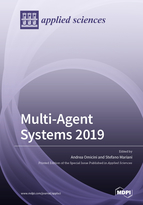Multi-Agent Systems 2019
A special issue of Applied Sciences (ISSN 2076-3417). This special issue belongs to the section "Computing and Artificial Intelligence".
Deadline for manuscript submissions: closed (31 January 2020) | Viewed by 36951
Special Issue Editors
Interests: distributed and pervasive systems; agents and multiagent systems; software engineering; intelligent systems; multi-paradigm programming languages; simulation; self-organization
Special Issues, Collections and Topics in MDPI journals
Interests: coordination; socio-technical systems; Internet of Things; self-organization; multi-agent systems; computational argumentation; AI in healthcare
Special Issues, Collections and Topics in MDPI journals
Special Issue Information
Dear Colleagues,
Research work done on intelligent agents and multi-agent systems has matured during the past decade, and many effective applications of this technology are currently being deployed. Although computational approaches for multi-agent systems have mainly emerged in the past few decades, scholars have been prolific with the variety of methods proposed to solve this paradigm. Different communities have emerged with multi-agent systems as their main research topic.
Multi-agent systems allow the development of distributed and intelligent applications in complex and dynamic environments. Systems of this kind play a crucial role in life, evidenced by the broad range of applied areas involved in their use, including manufacturing, management sciences, e-commerce, biotechnology, etc.
There are many reasons for the interest of researchers in this new discipline. Firstly, computational systems have gradually shifted towards a distributed paradigm where heterogeneous entities with different goals can enter and leave the system dynamically and interact with each other. Secondly, new computational systems should be able to negotiate with one another, typically on behalf of humans, in order to come to mutually acceptable agreements. As a consequence, autonomy, interaction, mobility, and openness are key concepts studied in the area.
The purpose of this Special Issue is to make known some of the advances made in this paradigm and try to show the current state of this technology by analysing different aspects, as well as its possible application to various domains. This review of the current state-of-the-art is not intended to make an exhaustive exploration of all the current existing works, but rather to try to give an overview of the research in agent technology, showing the high level of activity of this area.
Prof. Dr. Andrea Omicini
Dr. Stefano Mariani
Guest Editors
Manuscript Submission Information
Manuscripts should be submitted online at www.mdpi.com by registering and logging in to this website. Once you are registered, click here to go to the submission form. Manuscripts can be submitted until the deadline. All submissions that pass pre-check are peer-reviewed. Accepted papers will be published continuously in the journal (as soon as accepted) and will be listed together on the special issue website. Research articles, review articles as well as short communications are invited. For planned papers, a title and short abstract (about 100 words) can be sent to the Editorial Office for announcement on this website.
Submitted manuscripts should not have been published previously, nor be under consideration for publication elsewhere (except conference proceedings papers). All manuscripts are thoroughly refereed through a single-blind peer-review process. A guide for authors and other relevant information for submission of manuscripts is available on the Instructions for Authors page. Applied Sciences is an international peer-reviewed open access semimonthly journal published by MDPI.
Please visit the Instructions for Authors page before submitting a manuscript. The Article Processing Charge (APC) for publication in this open access journal is 2400 CHF (Swiss Francs). Submitted papers should be well formatted and use good English. Authors may use MDPI's English editing service prior to publication or during author revisions.
Keywords
- agent and multi-agent applications
- agent engineering: development techniques, tools, and platforms
- agent-based simulation: development techniques, tools, and platforms
- biologically-inspired approaches and methods
- agent-based collective intelligence
- multi-agent complex systems
- agent-based distributed problem solving
- human–robot/agent interaction
- agent-based intelligent control and manufacturing systems
- learning and adaptation in multi-agent systems
- methodologies for agent-based systems
- multi-robot systems
- negotiation and conflict resolution in multi-agent systems
- norms for multi-agent systems
- institutions for multi-agent systems
- reasoning in agent-based systems
- self-organization in multi-agent systems
- single and multi-agent planning and scheduling
- agent-based socio-technical systems
- teamwork, team formation, teamwork analysis
- trust and reputation in multi-agent systems







